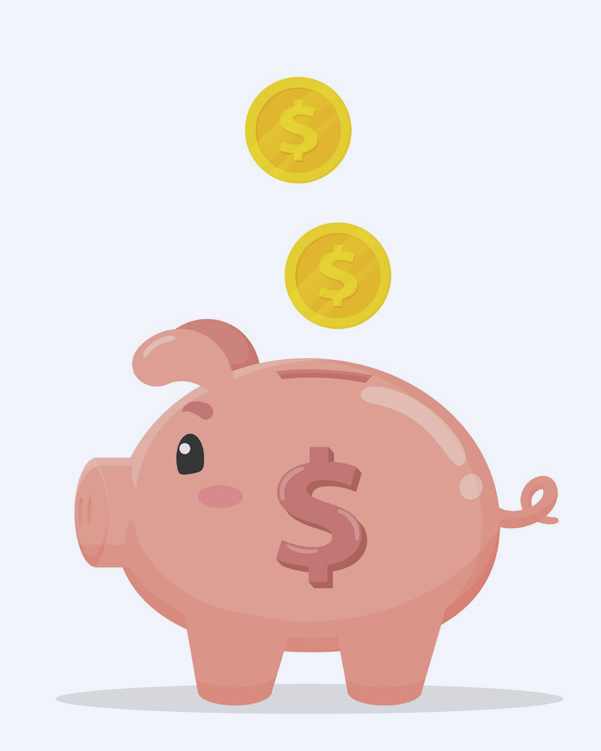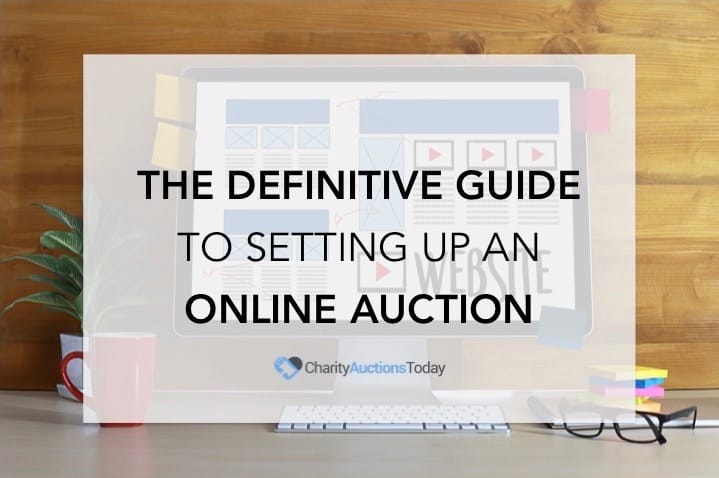Is it your first time in charge of your organization's fundraising auction?
Whether you're new at this and have no idea what to do next, or you volunteered to create the auction again this year, you're in the right place.
Don’t Just Be Silent Online — Make It Dynamic
You’ve learned how online silent auctions work. Now launch yours with real-time updates, bidder engagement, and seamless checkout built in.
Launch Your Online Silent AuctionLet's begin by first considering auction types and move on to reviewing the six steps to creating your silent auction.

Live vs. Virtual Silent Auctions: which should you choose?
We'll walk you through the details and how-tos of the three types of auctions to help you choose:
• Online (virtual—doesn't require a venue) • Live (can be silent or with an auctioneer) • Online and Live (Takes the most effort but raises the most funding)
What Is a Silent Auction?
Silent auctions, like traditional auctions, raise funds through attendees bidding on items donated by sponsors. The highest bid wins and the proceeds go to the organization or cause.
Unlike a traditional auction, however, a silent auction doesn’t have an auctioneer. Instead, attendees write their bids on bid sheets. Throughout the event, bidders can return to the bid sheet to see if they are still the highest bidder and/or raise their bid to secure the item. Fun and excitement can erupt when bidders get into a competitive bidding war for a single item.
Once you've selected the type of online auction you'll use, review how an online auction moves from start to finish in the six steps below. It's a helpful tool to help you organize a successful auction.
Six Easy Steps to your Silent Auction:

Pre-Planning
Two things to do before creating your auction 1. Determine whether you want a live or virtual silent auction. 2. Select your auction platform to determine which platform suits your organization or cause best.
Resources to help you with steps one and two:
Step 1:

Create an Auction Committee
Our online auctions are easy enough to be hosted by one person (seriously!) or a whole team. Live, in-person auctions usually require help, but don't worry—we'll show you how to structure your team.
As you assemble your auction team, consider these tips:
 Determine what roles need to be fulfilled
Determine what roles need to be fulfilled What tasks and responsibilities fall under each role?
What tasks and responsibilities fall under each role? Keep the committee focused and having fun!
Keep the committee focused and having fun!
Step 2:

Collect Donated Items
Asking for donations can seem daunting, but your community wants to help your worthy cause! In fact, we can help you streamline the collection and management of donated items. Here are some things to consider:
 Ask the right people for the right things! Your community will be glad to donate items. If you're a member of a Chamber of Commerce, ask the members for donations.
Ask the right people for the right things! Your community will be glad to donate items. If you're a member of a Chamber of Commerce, ask the members for donations. Make the donation process simple AND EASY!
Make the donation process simple AND EASY! Consider looking for a sponsor(s) for your auction. Tell them where their organization will be promoted (ads, social media, banners, emails, press releases, etc.), how many people they'll reach and what your organization will do to honor their generous donation. This will increase your bottom line!Here are a few companies that offer matching programs as part of their corporate giving initiatives.
Consider looking for a sponsor(s) for your auction. Tell them where their organization will be promoted (ads, social media, banners, emails, press releases, etc.), how many people they'll reach and what your organization will do to honor their generous donation. This will increase your bottom line!Here are a few companies that offer matching programs as part of their corporate giving initiatives.
Step 3:

Planning the Event
We know that planning an event can be stressful, but try to have fun! CharityAuctionsToday takes the guesswork out of the process, and we love that making it fun adds to its success!
To get the most out of your planning phase, consider:
 Make it EASY for your guests (bidders). Is the venue easy to get to? Did you pick the best day/time for them to attend? Easy parking? Consider your guests in every step you plan. Make it as simple for your bidders to attend!
Make it EASY for your guests (bidders). Is the venue easy to get to? Did you pick the best day/time for them to attend? Easy parking? Consider your guests in every step you plan. Make it as simple for your bidders to attend! Money-saving tips - check out some low to no-cost ideas!
Money-saving tips - check out some low to no-cost ideas! Make a checklist of everything you want to accomplish!
Make a checklist of everything you want to accomplish!
Step 4:

Publicize the Auction
Social media is a terrific way to reach your intended audience. Review our best practices to help harness social media's power to create a successful auction.
Other considerations for efficient fundraising:
 Create a buzz that translates into dollars for your organization
Create a buzz that translates into dollars for your organization Simple, easy, and FREE ways to spread the word. People love to contribute to causes—all you have to do is ask them.
Simple, easy, and FREE ways to spread the word. People love to contribute to causes—all you have to do is ask them. Leveraging your social media relationships without feeling pushy. Ask your friends for help to achieve your goal. Remember, people love to do good things.
Leveraging your social media relationships without feeling pushy. Ask your friends for help to achieve your goal. Remember, people love to do good things.- Utilize email. What member lists do you have access to? Member lists such as Chamber of Commerce, districts, organizations, etc. are excellent ways to reach out to prospective bidders personally.
Step 5:

Organize the Silent Auction
Online and live, in-person silent auctions are easy to run with some planning. Over the past 15 years, we have fine-tuned the planning process to make it easier for you. Here are a few ideas that might help along the way:
 Create checklists to get you through the planning, administration, and closing of each auction.
Create checklists to get you through the planning, administration, and closing of each auction. Be mindful about how you structure the auction for maximum bid potential. Do your items have clear and accurate descriptions? Is the auction beneficiary listed and advertised? We joke that an auction platform is like a dating app—you must use your best photos and words to reach your goals!
Be mindful about how you structure the auction for maximum bid potential. Do your items have clear and accurate descriptions? Is the auction beneficiary listed and advertised? We joke that an auction platform is like a dating app—you must use your best photos and words to reach your goals! Ask for help! Often volunteers are looking for "their role." You don't have to do this alone! Delegate!
Ask for help! Often volunteers are looking for "their role." You don't have to do this alone! Delegate!
Step 6:

Close the Silent Auction
Between swiping credit cards and assigning winning bidders, closing out an auction can seem intimidating. Our team of Auction Success Managers will be at your side as the auction closes in case you have questions.
Here are three end-of-auction tips:
 Close out your auction so that it is memorable for all participants. A memorable closing will help get them back for your next event!
Close out your auction so that it is memorable for all participants. A memorable closing will help get them back for your next event! Plan out and review all payment options to minimize unexpected fees or snags.
Plan out and review all payment options to minimize unexpected fees or snags. Touch base with all participants after the event (that includes your volunteers!). Let them know how valuable they are to your cause.
Touch base with all participants after the event (that includes your volunteers!). Let them know how valuable they are to your cause.
Frequently Asked Questions
What is an online silent auction and how does it work?
An online silent auction lets supporters browse items on a web page, place bids from any device, and receive outbid notifications until the auction closes. Highest eligible bid at closing wins and pays securely online.
How long should an online silent auction run?
Most organizations run 5–10 days. Shorter windows (3–5 days) create urgency; longer windows (10–14 days) help with discovery and sharing. Use a clear end time and your time zone.
Which items perform best online?
- Experiences: chef dinners, tours, lessons, VIP passes.
- Travel: flexible dates, low restrictions, clear blackout dates.
- Gift cards & services: easy to fulfill and ship.
Curate tightly—fewer, better items drive more competition.
How should we present items to maximize bids?
- 1–3 high-quality photos (hero + context + detail).
- Bulleted “What’s included,” restrictions, and expiration.
- Short benefit-focused headline and clear pickup/shipping info.
How do we set starting bids and bid increments online?
- Start at ~30–50% of fair market value (FMV).
- Use simple increments (5–10% of FMV) for momentum.
- Consider a Buy-It-Now at ~120–150% of FMV.
How do we prevent last-second “sniping” online?
Enable auto-extend (if available) so any bid placed in the final minutes extends the item by a short interval (e.g., 2–5 minutes). Announce this clearly on your page and reminders.
Should we enable proxy bidding (max bids)?
Yes—proxy bidding lets supporters set a maximum they’re willing to pay. The system bids automatically in increments, increasing participation without constant manual bidding.
What’s the smoothest registration setup for bidders?
- Short form (name, email, mobile) + wallet pay on file.
- Optional SMS opt-in for outbid and closing alerts.
- Clear rules link at signup (eligibility, shipping, taxes, deadlines).
How are payments handled and what goes on the receipt? (General information)
Winners pay online via card or wallet. Receipts should list item name, amount paid, and whether goods/services were received (and FMV if needed). This is general information, not tax advice.
What’s the best way to handle shipping or pickup for online winners?
Publish options on each item: local pickup windows, flat-rate shipping, or digital certificates. Specify who covers shipping and how to redeem experience items.
What promotion plan works best for online silent auctions?
- Preview (T-7–10 days): teaser items + “watch” feature.
- Launch: email + socials + ambassador shares with short link/QR.
- Final 72 hours: daily countdown, top items, closing times.
Do watchlists and alerts increase bidding activity?
Yes—encourage supporters to “watch” items. Outbid and closing-time alerts bring bidders back and raise final prices.
Should we stagger closing times by category?
Staggered closings (e.g., every 10–15 minutes by category) keep excitement high and let bidders pivot to their next priority, increasing overall revenue.
Should we include consignment items or set reserves online?
Use consignment sparingly—fees reduce your net. If you set reserves, keep them realistic and disclose clearly; too-high reserves can suppress bidding.
Can we sell the same experience to multiple winners to raise more money?
If the donor agrees, offer the item to the top two or three bidders at the same closing price. This works well for dinners, classes, and tours.
What rules and terms should appear on our auction page? (General information)
- Bidding increments, auto-extend policy, and closing times.
- Payment deadline, pickup/shipping details, and expiration windows.
- Eligibility and any local restrictions. General information, not legal advice.
How can we make our online auction accessible and inclusive? (General information)
- Use high-contrast text, captioned videos, and alt text for images.
- Keep forms short, mobile-friendly, and keyboard navigable.
- Offer content in key languages for your community where possible.
Any security tips for running an online silent auction? (General information)
Use HTTPS pages, trusted payment processors, and admin 2FA. Avoid sharing bidder data publicly and remove sensitive details from item photos. General information, not security advice.
Which metrics show our online auction is on track before it ends?
- Bidders registered per day and % items with ≥2 bids.
- Bids per item and average bid lift over FMV.
- Outbid alerts sent and top traffic sources (email/social/QR).
What should we do immediately after the auction closes?
- Trigger winner emails with payment links and pickup/shipping steps.
- Thank donors and sponsors publicly; share results within 48 hours.
- Run a short second-chance sale for unsold or unclaimed items.
💡 Try this in ChatGPT
- Summarize the article "6 Easy Steps to Creating Your Silent Auction" from https://ghost.charityauctionstoday.com/p/online-silent-auction/ in 3 bullet points for a board update.
- Turn the article "6 Easy Steps to Creating Your Silent Auction" (https://ghost.charityauctionstoday.com/p/online-silent-auction/) into a 60-second talking script with one example and one CTA.
- Extract 5 SEO keywords and 3 internal link ideas from "6 Easy Steps to Creating Your Silent Auction": https://ghost.charityauctionstoday.com/p/online-silent-auction/.
- Create 3 tweet ideas and a LinkedIn post that expand on this Guides topic using the article at https://ghost.charityauctionstoday.com/p/online-silent-auction/.
Tip: Paste the whole prompt (with the URL) so the AI can fetch context.
Tom Kelly
Tom Kelly, TEDx speaker and CEO of CharityAuctions.com, helps nonprofits raise millions through auctions and AI. He hosts The Million Dollar Nonprofit podcast and inspires leaders to live their legacy, not just leave it.
Table of contents
Create Your Auction
Raise 40% more with smart bidding tools






